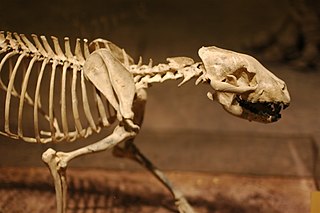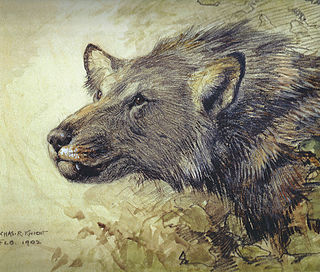
Aelurodon is an extinct canid genus of the subfamily Borophaginae which lived from the Barstovian land mammal age of the middle Miocene to the late Miocene epoch. Aelurodon existed for approximately 10.7 million years.

The extinct Borophaginae form one of three subfamilies found within the canid family. The other two canid subfamilies are the extinct Hesperocyoninae and extant Caninae. Borophaginae, called "bone-crushing dogs", were endemic to North America during the Oligocene to Pliocene and lived roughly 34—2.5 million years ago, existing for about 33.5 million years.

Phlaocyon is an extinct genus of the Borophaginae subfamily of canids native to North America. It lives from the Early Oligocene to the Early Miocene epoch 33.3–16.3 Mya, existing for approximately 17.3 million years. It is closely related to Cynarctoides.

Hesperocyon is an extinct genus of canids that was endemic to North America, ranging from southern Canada to Colorado. It appeared during the Uintan age, –Bridgerian age (NALMA) of the Mid-Eocene– 42.5 Ma to 31.0 Ma. (AEO). Hesperocyon existed for approximately 11.5 million years.

The John Day Formation is a series of rock strata exposed in the Picture Gorge district of the John Day River basin and elsewhere in north-central Oregon in the United States. The Picture Gorge exposure lies east of the Blue Mountain uplift, which cuts southwest–northeast through the Horse Heaven mining district northeast of Madras. Aside from the Picture Gorge district, which defines the type, the formation is visible on the surface in two other areas: another exposure is in the Warm Springs district west of the uplift, between it and the Cascade Range, and the third is along the south side of the Ochoco Mountains. All three exposures, consisting mainly of tuffaceous sediments and pyroclastic rock rich in silica, lie unconformably between the older rocks of the Clarno Formation below and Columbia River basalts above.

The Caninae, known as canines, are one of three subfamilies found within the canid family. The other two canid subfamilies are the extinct Borophaginae and Hesperocyoninae. The Caninae includes all living canids and their most recent fossil relatives. Their fossils were first found in North America and dated to the Oligocene era, then spreading to Asia at the end of the Miocene era, some 7 million to 8 million years ago.

The extinct Hesperocyoninae are one of three subfamilies found within the canid family. The other two canid subfamilies are the extinct Borophaginae and extant Caninae.
Nothocyon is an extinct genus of carnivoran in the family Subparictidae which inhabited North America during the late Oligocene. At one time, many species of the dog family Canidae were placed in Nothocyon, but new fossils showed that the type species of Nothocyon, N. geismarianus, is more closely related to bears. The other species have been reassigned to other genera such as Cormocyon.
Cynarctina is an extinct clade of the Borophaginae subfamily of canids native to North America. They lived from the Early to Middle Miocene 16.0—10.3 Ma, existing for approximately 5.7 million years. Cynarctines had rounded cusps on the molar teeth, similar to those seen in living bears, suggesting that they were likely omnivores.
Borophagina is a subtribe of the Borophaginae, a group of extinct canids. They inhabited much of North America from the Early Miocene to the Zanclean stage of the Pliocene, 20.6—3.6 Mya, and existed for approximately 17 million years.

Borophagus hilli is an extinct species of the genus Borophagus of the subfamily Borophaginae, a group of canids endemic to North America from the Late Miocene until the Pliocene.

Borophagus diversidens is an extinct species of the genus Borophagus of the subfamily Borophaginae, a group of canids endemic to North America from the late Miocene epoch through the Pliocene epoch 4.9—1.8 Ma.

Borophagus secundus is an extinct species of the genus Borophagus of the subfamily Borophaginae, a group of canids endemic to North America from the Early Miocene epoch through the Late Miocene epoch. Borophagus secundus existed for approximately 17.7 million years.
Phlaocyon achoros is an extinct species of the genus Phlaocyon, belonging to the subfamily Borophaginae and tribe Phlaocyonini, a canid which inhabited the southeastern North America from the Late Oligocene to Miocene living 24.6—20.8 mya and existed for approximately 4.2 million years.
Phlaocyon latidens is an extinct species of the genus Phlaocyon, belonging to the subfamily Borophaginae and tribe Phlaocyonini, a canid which inhabited northwestern North America from the Late Oligocene to Miocene living 33.3–20.6 mya and existed for approximately 12.7 million years.
Phlaocyon mariae is an extinct species of the genus Phlaocyon, belonging to the subfamily Borophaginae and tribe Phlaocyonini, a canid which inhabited central western North America from the Miocene living 20.6–16.3 Ma, and existed for approximately 4.3 million years.
The Sharps Formation is a geologic formation in South Dakota. It preserves fossils dating back to the Paleogene.
The Dove Spring Formation is a geologic formation in the western Mojave Desert of California. It preserves fossils dating back to the Miocene epoch of the Neogene period.
Phlaocyon yatkolai is an extinct species of canid mammal known from the early Hemingfordian Runningwater Formation, Box Butte County, Nebraska (42.2°N 103.1°W, paleocoordinates 42.9°N 99.2°W).
Phlaocyon minor is an extinct species of canid mammal known from the Miocene-Oligocene of the United States










